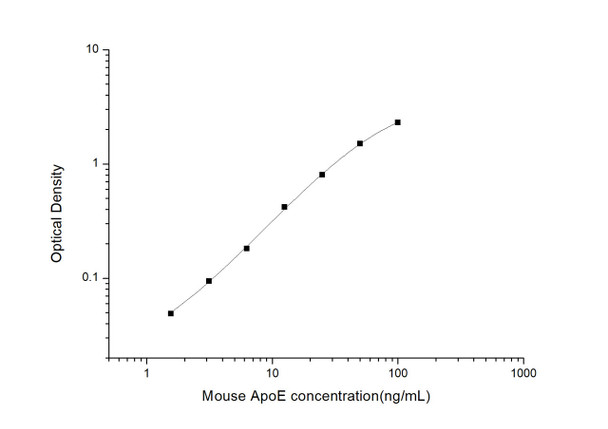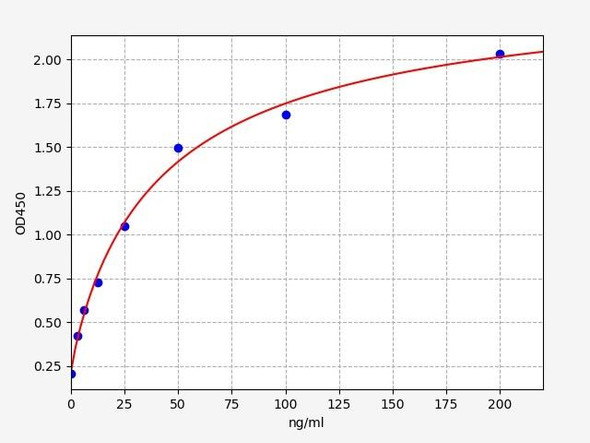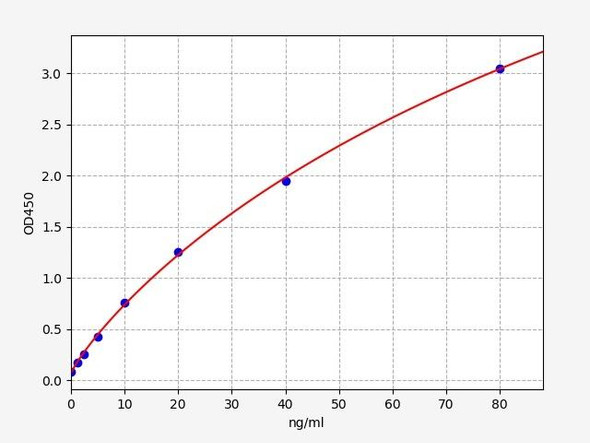Mouse Cell Biology ELISA Kits 2
Mouse APO-E (Apolipoprotein E) ELISA Kit (MOES00724)
- SKU:
- MOES00724
- Product Type:
- ELISA Kit
- Size:
- 96 Assays
- Uniprot:
- P08226
- Sensitivity:
- 0.94ng/mL
- Range:
- 1.56-100ng/mL
- ELISA Type:
- Sandwich
- Synonyms:
- Apo-E, MGC1571, apolipoprotein E3
- Reactivity:
- Mouse
- Sample Type:
- Serum, plasma and other biological fluids
- Research Area:
- Cell Biology
Description
| Assay type: | Sandwich |
| Format: | 96T |
| Assay time: | 4.5h |
| Reactivity: | Mouse |
| Detection Method: | Colormetric |
| Detection Range: | 1.56-100 ng/mL |
| Sensitivity: | 0.94 ng/mL |
| Sample Volume Required Per Well: | 100µL |
| Sample Type: | Serum, plasma and other biological fluids |
| Specificity: | This kit recognizes Mouse APO-E in samples. No significant cross-reactivity or interference between Mouse APO-E and analogues was observed. |
This ELISA kit uses Sandwich-ELISA as the method. The micro ELISA plate provided in this kit has been pre-coated with an antibody specific to Mouse APO-E. Standards or samples are added to the appropriate micro ELISA plate wells and combined with the specific antibody. Then a biotinylated detection antibody specific for Mouse APO-E and Avidin-Horseradish Peroxidase (HRP) conjugate are added to each micro plate well successively and incubated. Free components are washed away. The substrate solution is added to each well. Only those wells that contain Mouse APO-E, biotinylated detection antibody and Avidin-HRP conjugate will appear blue in color. The enzyme-substrate reaction is terminated by adding Stop Solution and the color turns yellow. The optical density (OD) is measured spectrophotometrically at a wavelength of 450 nm ± 2 nm. The OD value is proportional to the concentration of Mouse APO-E. The concentration of Mouse APO-E in samples can be calculated by comparing the OD of the samples to the standard curve.
| UniProt Protein Function: | APOE: Mediates the binding, internalization, and catabolism of lipoprotein particles. It can serve as a ligand for the LDL (apo B/E) receptor and for the specific apo-E receptor (chylomicron remnant) of hepatic tissues. Defects in APOE are a cause of hyperlipoproteinemia type 3 (HLPP3); also known as familial dysbetalipoproteinemia. Individuals with HLPP3 are clinically characterized by xanthomas, yellowish lipid deposits in the palmar crease, or less specific on tendons and on elbows. The disorder rarely manifests before the third decade in men. In women, it is usually expressed only after the menopause. The vast majority of the patients are homozygous for APOE*2 alleles. More severe cases of HLPP3 have also been observed in individuals heterozygous for rare APOE variants. The influence of APOE on lipid levels is often suggested to have major implications for the risk of coronary artery disease (CAD). Individuals carrying the common APOE*4 variant are at higher risk of CAD. Genetic variations in APOE are associated with Alzheimer disease type 2 (AD2). It is a late-onset neurodegenerative disorder characterized by progressive dementia, loss of cognitive abilities, and deposition of fibrillar amyloid proteins as intraneuronal neurofibrillary tangles, extracellular amyloid plaques and vascular amyloid deposits. The major constituent of these plaques is the neurotoxic amyloid-beta-APP 40-42 peptide (s), derived proteolytically from the transmembrane precursor protein APP by sequential secretase processing. The cytotoxic C-terminal fragments (CTFs) and the caspase-cleaved products such as C31 derived from APP, are also implicated in neuronal death. The APOE*4 allele is genetically associated with the common late onset familial and sporadic forms of Alzheimer disease. Risk for AD increased from 20% to 90% and mean age at onset decreased from 84 to 68 years with increasing number of APOE*4 alleles in 42 families with late onset AD. Thus APOE*4 gene dose is a major risk factor for late onset AD and, in these families, homozygosity for APOE*4 was virtually sufficient to cause AD by age 80. The mechanism by which APOE*4 participates in pathogenesis is not known. Defects in APOE are a cause of sea-blue histiocyte disease (SBHD); also known as sea-blue histiocytosis. This disorder is characterized by splenomegaly, mild thrombocytopenia and, in the bone marrow, numerous histiocytes containing cytoplasmic granules which stain bright blue with the usual hematologic stains. The syndrome is the consequence of an inherited metabolic defect analogous to Gaucher disease and other sphingolipidoses. Defects in APOE are a cause of lipoprotein glomerulopathy (LPG). LPG is an uncommon kidney disease characterized by proteinuria, progressive kidney failure, and distinctive lipoprotein thrombi in glomerular capillaries. It mainly affects people of Japanese and Chinese origin. The disorder has rarely been described in Caucasians. Belongs to the apolipoprotein A1/A4/E family. |
| UniProt Protein Details: | Protein type:Lipid-binding; Secreted, signal peptide; Secreted Cellular Component: cell soma; cell surface; chylomicron; cytoplasm; dendrite; early endosome; endoplasmic reticulum; endosome; extracellular matrix; extracellular region; extracellular space; extrinsic to external side of plasma membrane; Golgi apparatus; late endosome; lysosome; membrane; microtubule; nuclear envelope; nucleus; plasma membrane Molecular Function:antioxidant activity; beta-amyloid binding; cholesterol binding; cholesterol transporter activity; heparin binding; hydroxyapatite binding; identical protein binding; lipid binding; lipid transporter activity; low-density lipoprotein receptor binding; metal chelating activity; phospholipid binding; protein binding; protein homodimerization activity; receptor binding; tau protein binding Biological Process: aging; artery morphogenesis; axon regeneration; cellular calcium ion homeostasis; cGMP-mediated signaling; cholesterol biosynthetic process; cholesterol catabolic process; cholesterol efflux; cholesterol homeostasis; cholesterol metabolic process; fatty acid homeostasis; G-protein coupled receptor protein signaling pathway; lipid homeostasis; lipid metabolic process; lipid transport; lipoprotein biosynthetic process; lipoprotein catabolic process; lipoprotein metabolic process; long-chain fatty acid transport; maintenance of cellular localization; negative regulation of blood coagulation; negative regulation of blood vessel endothelial cell migration; negative regulation of cholesterol biosynthetic process; negative regulation of endothelial cell proliferation; negative regulation of inflammatory response; negative regulation of lipid biosynthetic process; negative regulation of MAP kinase activity; negative regulation of neuron apoptosis; nitric oxide mediated signal transduction; phospholipid efflux; positive regulation of axon extension; positive regulation of cGMP biosynthetic process; positive regulation of lipid biosynthetic process; positive regulation of low-density lipoprotein receptor catabolic process; positive regulation of membrane protein ectodomain proteolysis; positive regulation of nitric-oxide synthase activity; protein import; protein localization; receptor-mediated endocytosis; regulation of axon extension; regulation of Cdc42 protein signal transduction; regulation of cholesterol transport; regulation of gene expression; response to dietary excess; response to oxidative stress; reverse cholesterol transport; transport; triacylglycerol catabolic process; triacylglycerol metabolic process; vasodilation; virus assembly |
| NCBI Summary: | This gene encodes a member of the apolipoprotein A1/A4/E family of proteins. This protein is involved in the transport of lipoproteins in the blood. It binds to a specific liver and peripheral cell receptor, and is essential for the normal catabolism of triglyceride-rich lipoprotein constituents. Homozygous knockout mice for this gene accumulate high levels of cholesterol in the blood and develop atherosclerosis. Different alleles of this gene have been associated with either increased risk or a protective effect for Alzheimer's disease in human patients. This gene maps to chromosome 7 in a cluster with the related apolipoprotein C1, C2 and C4 genes. [provided by RefSeq, Apr 2015] |
| UniProt Code: | P08226 |
| NCBI GenInfo Identifier: | 802084029 |
| NCBI Gene ID: | 11816 |
| NCBI Accession: | NP_001292748. 1 |
| UniProt Related Accession: | P08226 |
| Molecular Weight: | 37. 9 |
| NCBI Full Name: | apolipoprotein E |
| NCBI Synonym Full Names: | apolipoprotein E |
| NCBI Official Symbol: | Apoe |
| NCBI Official Synonym Symbols: | Apo-E; AI255918 |
| NCBI Protein Information: | apolipoprotein E |
| UniProt Protein Name: | Apolipoprotein E |
| Protein Family: | Apolipoprotein |
| UniProt Gene Name: | Apoe |
| UniProt Entry Name: | APOE_MOUSE |
As the OD values of the standard curve may vary according to the conditions of the actual assay performance (e. g. operator, pipetting technique, washing technique or temperature effects), the operator should establish a standard curve for each test. Typical standard curve and data is provided below for reference only.
| Concentration (ng/mL) | O.D | Average | Corrected |
| 100 | 2.336 2.394 | 2.365 | 2.311 |
| 50 | 1.554 1.56 | 1.557 | 1.503 |
| 25 | 0.869 0.845 | 0.857 | 0.803 |
| 12.5 | 0.466 0.484 | 0.475 | 0.421 |
| 6.25 | 0.248 0.224 | 0.236 | 0.182 |
| 3.13 | 0.161 0.135 | 0.148 | 0.094 |
| 1.56 | 0.098 0.108 | 0.103 | 0.049 |
| 0 | 0.053 0.055 | 0.054 | -- |
Precision
Intra-assay Precision (Precision within an assay): 3 samples with low, mid range and high level Mouse APO-E were tested 20 times on one plate, respectively.
Inter-assay Precision (Precision between assays): 3 samples with low, mid range and high level Mouse APO-E were tested on 3 different plates, 20 replicates in each plate.
| Intra-assay Precision | Inter-assay Precision | |||||
| Sample | 1 | 2 | 3 | 1 | 2 | 3 |
| n | 20 | 20 | 20 | 20 | 20 | 20 |
| Mean (ng/mL) | 5.30 | 15.90 | 50.00 | 5.40 | 16.60 | 53.60 |
| Standard deviation | 0.40 | 0.70 | 2.20 | 0.30 | 1.00 | 2.20 |
| C V (%) | 7.55 | 4.40 | 4.40 | 5.56 | 6.02 | 4.10 |
Recovery
The recovery of Mouse APO-E spiked at three different levels in samples throughout the range of the assay was evaluated in various matrices.
| Sample Type | Range (%) | Average Recovery (%) |
| Serum (n=5) | 94-107 | 101 |
| EDTA plasma (n=5) | 90-106 | 97 |
| Cell culture media (n=5) | 92-104 | 98 |
Linearity
Samples were spiked with high concentrations of Mouse APO-E and diluted with Reference Standard & Sample Diluent to produce samples with values within the range of the assay.
| Serum (n=5) | EDTA plasma (n=5) | Cell culture media (n=5) | ||
| 1:2 | Range (%) | 90-106 | 84-97 | 93-106 |
| Average (%) | 97 | 91 | 99 | |
| 1:4 | Range (%) | 95-111 | 84-98 | 96-110 |
| Average (%) | 103 | 90 | 102 | |
| 1:8 | Range (%) | 101-116 | 86-99 | 96-109 |
| Average (%) | 107 | 91 | 104 | |
| 1:16 | Range (%) | 94-110 | 85-98 | 96-112 |
| Average (%) | 102 | 90 | 103 |
An unopened kit can be stored at 4°C for 1 month. If the kit is not used within 1 month, store the items separately according to the following conditions once the kit is received.
| Item | Specifications | Storage |
| Micro ELISA Plate(Dismountable) | 8 wells ×12 strips | -20°C, 6 months |
| Reference Standard | 2 vials | |
| Concentrated Biotinylated Detection Ab (100×) | 1 vial, 120 µL | |
| Concentrated HRP Conjugate (100×) | 1 vial, 120 µL | -20°C(shading light), 6 months |
| Reference Standard & Sample Diluent | 1 vial, 20 mL | 4°C, 6 months |
| Biotinylated Detection Ab Diluent | 1 vial, 14 mL | |
| HRP Conjugate Diluent | 1 vial, 14 mL | |
| Concentrated Wash Buffer (25×) | 1 vial, 30 mL | |
| Substrate Reagent | 1 vial, 10 mL | 4°C(shading light) |
| Stop Solution | 1 vial, 10 mL | 4°C |
| Plate Sealer | 5 pieces | |
| Product Description | 1 copy | |
| Certificate of Analysis | 1 copy |
- Set standard, test sample and control (zero) wells on the pre-coated plate and record theirpositions. It is recommended to measure each standard and sample in duplicate. Note: addall solutions to the bottom of the plate wells while avoiding contact with the well walls. Ensuresolutions do not foam when adding to the wells.
- Aliquot 100µl of standard solutions into the standard wells.
- Add 100µl of Sample / Standard dilution buffer into the control (zero) well.
- Add 100µl of properly diluted sample (serum, plasma, tissue homogenates and otherbiological fluids) into test sample wells.
- Cover the plate with the sealer provided in the kit and incubate for 90 min at 37°C.
- Aspirate the liquid from each well, do not wash. Immediately add 100µL of BiotinylatedDetection Ab working solution to each well. Cover the plate with a plate seal and gently mix. Incubate for 1 hour at 37°C.
- Aspirate or decant the solution from the plate and add 350µL of wash buffer to each welland incubate for 1-2 minutes at room temperature. Aspirate the solution from each well andclap the plate on absorbent filter paper to dry. Repeat this process 3 times. Note: a microplatewasher can be used in this step and other wash steps.
- Add 100µL of HRP Conjugate working solution to each well. Cover with a plate seal andincubate for 30 min at 37°C.
- Aspirate or decant the solution from each well. Repeat the wash process for five times asconducted in step 7.
- Add 90µL of Substrate Reagent to each well. Cover with a new plate seal and incubate forapproximately 15 min at 37°C. Protect the plate from light. Note: the reaction time can beshortened or extended according to the actual color change, but not by more than 30min.
- Add 50 µL of Stop Solution to each well. Note: Adding the stop solution should be done inthe same order as the substrate solution.
- Determine the optical density (OD value) of each well immediately with a microplate readerset at 450 nm.






